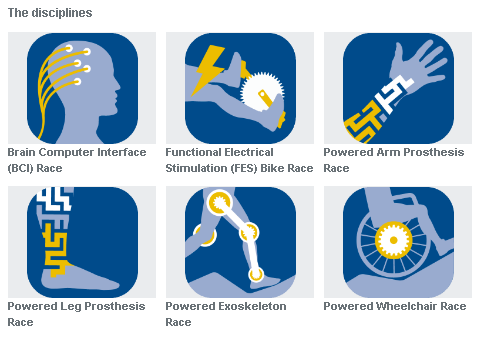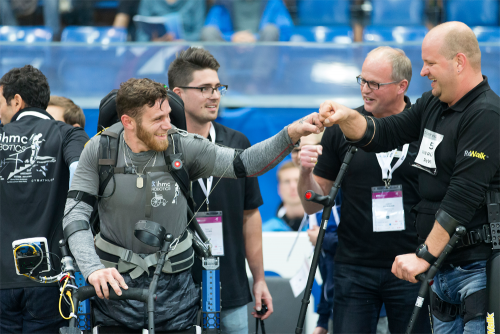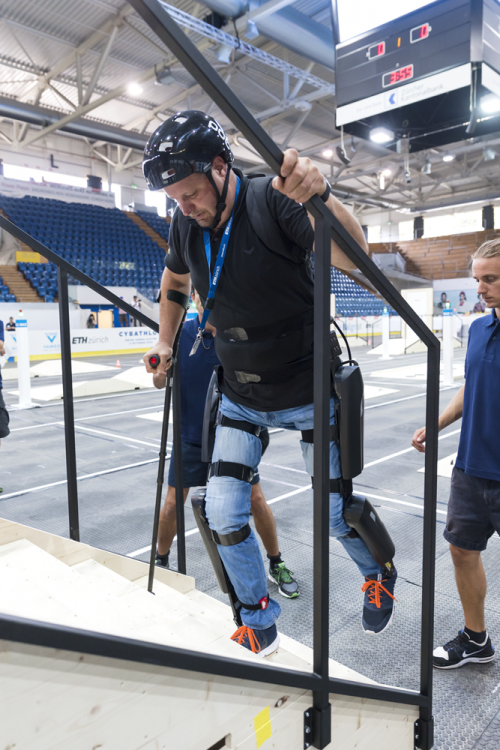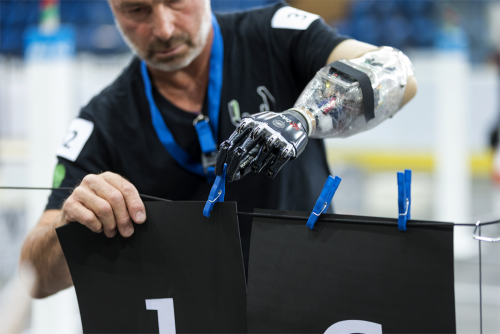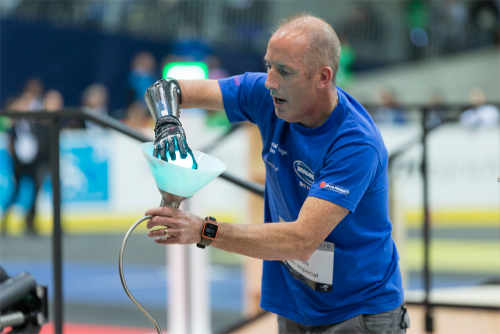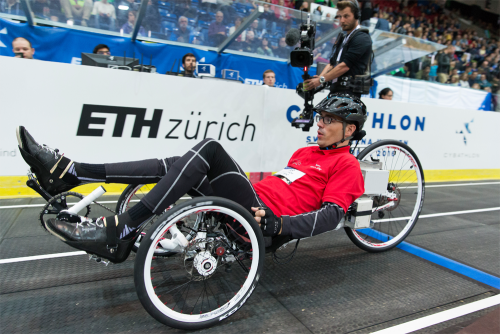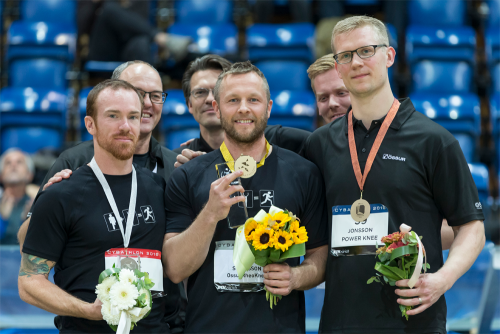Cybathlon: Cyborgs Compete for the Gold Medal

Man versus machine has quickly become man merges with machine as assistive technologies continue to develop. Today, the loss of a limb does not automatically translate into the loss of mobility. This year introduced the Cybathlon, where athletes compete for gold using their assistive technologies. Prosthetics range from body-powered replacements to high-tech interfaces that involve direct brain control.
https://www.youtube.com/watch?time_continue=6&v=KAVcVfKoYwc
With names like Oscar Pistorius making history as the first double amputee to compete in the able-bodied Olympics, it should come as no surprise that an Olympics for those enabled with assistive technologies was on the horizon. On October 8, 2016, cyborg athletes took to the field for a more sci-fi take on traditional sports. Held in Zurich, Switzerland, the Cybathlon challenged differently enabled athletes and engineers in six main events.
Instead of events that challenge the edge of human endurance, the Cybathlon looks at the power resulting from a synergy between man and machine. Every athlete, called a pilot in these events, overcame a mobility challenge ranging from a missing limb to paralysis. Without assistive technology, none of the competitors could have made it through the events. Only by effectively using advanced prosthesis and other technologies could these athletes finish the course. Events included races using robotic exoskeletons, bikes, motorized wheelchairs, powered prosthetic arms and legs, and even a unique race on a virtual track.
A decade ago, spinal cord injuries almost always meant a life of limited mobility in a wheelchair. Today, exoskeletons offer a range of mobility options. Even with recent advances by companies like Ekso Bionics and ReWalk Robotics, exoskeleton technology has a long way to go. Yes, some competitors managed to successfully navigate the course, but some of the entrants never even made it to the line. There were 16 teams registered from the event, but half dropped out before the first day of the Cybathlon.
The exoskeleton race consisted of challenges like standing up from a sitting position and then returning to a sitting position. Pilots needed to navigate a slalom, walk/run up a ramp, manage a doorway, walk on stepping stones, and go up and down stairs. Able-bodied folks might not perceive these challenges as true challenges, but for those who suffer from paralytic injuries, just that amount of improved mobility would be life-changing.
The powered prosthetics races included arms and legs, forcing pilots to perform daily activities using very precise steps. Those with below-the-knee amputations used powered prosthetics, while those with above-the-knee amputations could use any type of passive or active prosthetic. For example, the Cheetah feet used by Pistorius fall under the heading of passive because they are entirely body-powered.
Interestingly enough, the winner of the arm prosthetic race turned out to be a seemingly less advanced option: a body-powered gripping tool. Imagine an old-fashioned hook made light-weight, durable and more maneuverable.
Many of the prosthetics and pilots performed outstandingly, racking up perfect scores on a number of tasks. The exoskeleton race was the only event where no pilot managed to earn full points for completion.
In each category, there were some clear standouts. For the Brain-Computer Interface (BCI) race, the clear winner was designer Brain Tweakers and pilot Numa Poujouly, representing Switzerland. In the Functional Electrical Stimulation (FES) Bike Race, Mark Muhn of Team Cleveland, representing the United States, rolled to a rapid victory. Proficiency with arm prosthetics went to the Netherlands, DIPO Power and their pilot Robert (Bob) Radocy. RHEO KNEE from Iceland jogged home to win the gold piloted by Helgi Sveinsson. Germany's ReWalk exoskeleton, piloted by Andre Van Rüschen, took the win on time but failed to earn a perfect score of 660 for completed tasks. Finally, athletes on wheels zipped through the course, with the Swiss HSR Enhanced team and pilot Florian Hauser edging out the competition.
The BCI race was particularly interesting, since it's the control mechanism that may just be the biggest stumbling block to a fully functioning and integrated prosthetic limb. Currently, many prosthetics function using muscle cues or external control mechanisms, slowing function and forcing users to concentrate and actually pilot their replacement limb. In the BCI race, pilots used no physical controls to manipulate their avatars around the virtual track. Improvements in this area may see the development of a complete prosthetic within the next decade.
Consider breakthroughs like the one being worked on at DARPA. They are currently testing a prosthetic that returns the sense of touch to a missing limb. While users report that the stimulus is not an exact sensation, they can identify where they are being touched on the limb, without using a secondary sense, like sight.
As assistive technologies develop, we might see a time when disabilities disappear as prosthetics create an opportunity that turns the disabled into the highly enabled. Consider the fin prosthetic currently known as the Neptune in the works. With 360-degree adjustable movement, this prosthetic streamlines water propulsion for its user. It may just be a matter of time before we see more and more Paralympic medalists participating in the able-bodied Olympics.
Sources:
http://www.cybathlon.ethz.ch/en/for-the-media/photo-gallery.html
http://www.cybathlon.ethz.ch/en/the-disciplines.html
http://www.cybathlon.ethz.ch/en/cybathlon-news/cybathlon-results.html
https://www.ethz.ch/content/dam/ethz/special-interest/conference-websites-dam/cybathlon-dam/documents/2016-08-10_Cybathlon_RacesRules.pdf
http://robots.ihmc.us/cybathlon/
http://spectrum.ieee.org/the-human-os/biomedical/bionics/at-the-worlds-first-cyborg-olympics-manmachine-hybrids-raced-for-the-gold
http://www.hongkiat.com/blog/amazing-prosthetic-limbs-organs/
http://www.takepart.com/photos/amazing-prosthetic-limbs/pistorius-cheetah-flex-foot-blades
http://www.digitaltrends.com/cool-tech/best-prosthetic-limbs/
http://www.telegraph.co.uk/sport/olympics/athletics/9454624/Oscar-Pistorius-knocked-out-of-London-2012-Olympics-but-his-achievements-will-resound-for-years-to-come.html
Thanks for helping to keep our community civil!
Notify staff privately
You flagged this as spam. Undo flag.Flag Post
It's Spam
This post is an advertisement, or vandalism. It is not useful or relevant to the current topic.
This post is an advertisement, or vandalism. It is not useful or relevant to the current topic.
You flagged this as spam. Undo flag.Flag Post


